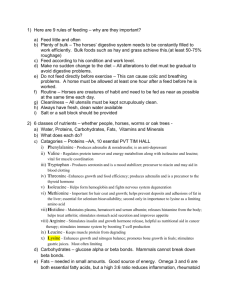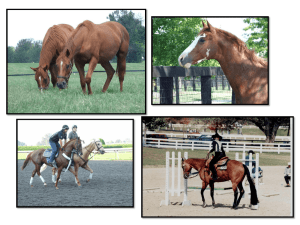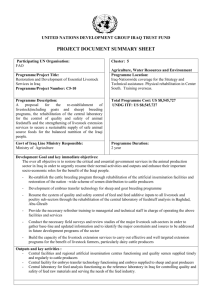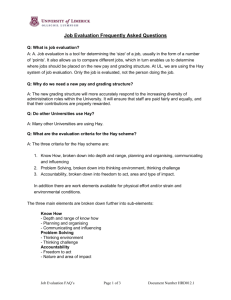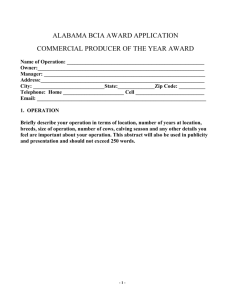Department/Unit Name - Cooperative Extension
advertisement
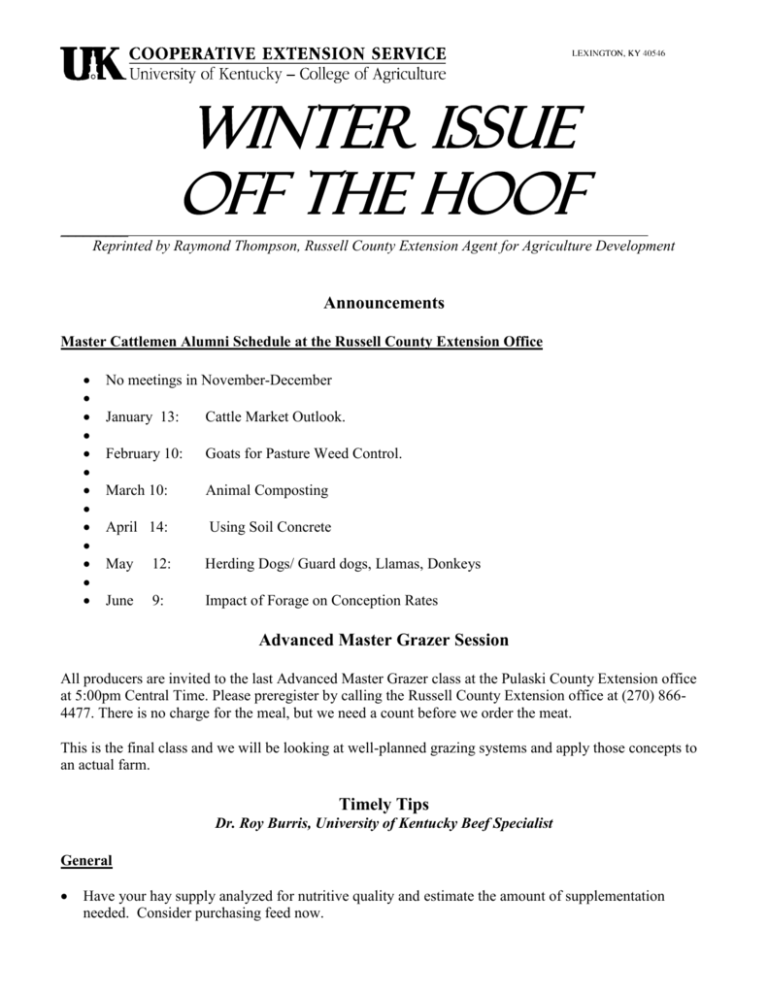
Winter Issue off the hoof _________ Lake Cumberland Area Reprinted by Raymond Thompson, Russell County 2010 Extension Agent for Agriculture Development November Announcements Master Cattlemen Alumni Schedule at the Russell County Extension Office No meetings in November-December January 13: Cattle Market Outlook. February 10: Goats for Pasture Weed Control. March 10: Animal Composting April 14: Using Soil Concrete May 12: Herding Dogs/ Guard dogs, Llamas, Donkeys June 9: Impact of Forage on Conception Rates Advanced Master Grazer Session All producers are invited to the last Advanced Master Grazer class at the Pulaski County Extension office at 5:00pm Central Time. Please preregister by calling the Russell County Extension office at (270) 8664477. There is no charge for the meal, but we need a count before we order the meat. This is the final class and we will be looking at well-planned grazing systems and apply those concepts to an actual farm. Timely Tips Dr. Roy Burris, University of Kentucky Beef Specialist General Have your hay supply analyzed for nutritive quality and estimate the amount of supplementation needed. Consider purchasing feed now. Don’t waste your feed resources. Avoid excessive mud in the feeding area. Hay feeding areas can be constructed by putting rock on geotextile fabric. Feed those large round bales in hay “rings” to avoid waste. Spring-calving cow herd Culling decisions should be made prior to winter feeding for best use of feed resources. Consider open, poor-producing and aged cows as candidates for culling. Evaluate body condition of cows after weaning their calves. Sort thin (less than CS5) cows away from the cow herd and feed to improve their condition. Two and three-year olds may need extra attention now. Dry cows in good condition can utilize crop residues and lower quality hay now (but don’t let them lose any more body condition). Save higher quality feed until calving time. Keep a good mineral supplement with vitamin A available. Replacement heifers require attention during the winter, too. Weaned heifer calves should gain at an adequate rate to attain their “target” breeding weight (2/3 of their mature weight) by May 1. If you need to replace cows, consider buying bred heifers in some of the Kentucky Certified Replacement Heifer sales which are being held across the state this month. A postweaning feeding period will allow you to put rapid, economical gains on weaned calves, keep them through the fall “runs” and allow you to participate in Kentucky CPH-45 sales. Consider this health and marketing program which is designed for producers which are doing a good job of producing high quality feeder calves. Fall-calving herd Continue to watch fall-calving cows this month. Catch up on processing of calves including identification, castration and vaccinations. Vaccinate the cows while they are open and prior to the breeding season. Move cows to accumulated pasture or increase feed now. Start the breeding season about November 25 for calving to begin in September of 2011. If you are using AI and/or estrous synchronization, get your supplies together now. Don’t forget Breeding Soundness Evaluations (BSE) on your bulls. Make final selection of replacement heifers now. Reminders This is a good time to take soil tests and make fertility adjustments (phosphate, potash and lime) to your pastures. This is also a good time to freeze-brand bred yearling heifers and additions to the breeding herd. Graze alfalfa this month after a “freeze-down” (24 degrees for a few hours). Time to Inventory, Purchase Hay Katie Pratt, Agricultural Communications Specialist, University of Kentucky Due to dry conditions, the majority of Kentucky livestock producers are already into their winter feeding 2 programs which some began as early as September. Producers need to inventory their hay supplies now to ensure they have enough to last through the winter. If they find they’re short, buying additional hay now can save them a lot of headaches later, said Tom Keene, hay marketing specialist with the University of Kentucky College of Agriculture. The good news is Kentucky forage producers had prime haymaking weather earlier this year and were able to get good yields due to adequate springtime moisture. “During a normal season, we would have had a surplus of hay,” Keene said. However, the timely rains diminished in July for some areas of the state and haven’t returned in significant amounts in most places since then. According to the most recent Kentucky Weekly Crop and Weather Report, about 90 percent of the state’s pastureland was rated either poor or very poor. “Even if we got some much needed rain, it is unlikely that pastures will recover enough to provide very many grazing days before cold weather sets in during December and January,” he said. “So those currently feeding hay will probably be doing so through March of 2011.” When calculating whether additional hay is needed, producers should consider their current supply, how much they feed their livestock each day, and account for feeding and storage losses. If producers have trouble determining these calculations, they can get assistance from their county extension agent for agriculture and natural resources. If the calculations show a need for additional hay, producers should go ahead and purchase some, Keene said. “By buying hay now, producers will have a bigger selection of quality hay, be more likely to find hay close to home and in the packaging they want,” he said. “The longer it’s put off, the more trouble producers will have meeting these criteria. The cost is also going to be better now.” To get the most out of current hay supplies, producers should have their hay tested. The Kentucky Department of Agriculture offers a forage testing program. “Hay testing helps producers feed the correct amount of hay with the right amount of supplements to meet their animals’ nutritional needs,” Keene said. “It can help producers feed hay more economically and efficiently.” For more information on the Kentucky Department of Agriculture’s testing program or hay for sale across the state, visit http://www.kyagr.com/marketing/forage/index.htm. Kentucky Beef Cattle Market Update Kenny Burdine, Livestock Marketing Specialist, University of Kentucky The fourth quarter is typically the lowest price quarter for Kentucky feeder cattle. During the last 5 years, we have watched 5wt steer prices drop by an average of $14 per cwt. and 7wt steers drop by an average of $11 per cwt. from August to December. We have seen the beginnings of this same pattern in 2010 as 3 prices for 5wt steers have fallen by about $10 per cwt. and 7wts by $7 per cwt. through October. See the following chart. Not surprisingly, the most profitable time to place stocker cattle into backgrounding programs over the last few years has been in the fourth quarter. This is primarily because calf prices have been low and feed costs have been reasonable during those times. If 2010 follows a typical pattern, we are very near the bottom of the market as we speak. So, it’s worth taking a look at the current backgrounding outlook for winter. Feed prices are clearly going to be higher this year. Corn prices have rallied since summer and are well above $5 as we speak. Commodity feeds are usually an attractively priced alternative, but we are currently working though some supply disruptions in those markets. A third option is hay, which is still reasonably priced, but quality is always the big question there. Regardless of which feed route is chosen, producers should really push the pencil on feed and other costs to estimate cost of gain on winter backgrounded cattle. On the revenue side, the expected margin looks pretty attractive. As an example, 500 to 600 lb Medium and Large Frame #1 steers have been selling for about $110 per cwt on a state average basis, which is around $600 per head. At the same time, spring feeder cattle futures are trading around $110 to $115, which suggests a local price for 8wts above $1 per pound or $850 per head. A $250 per head margin is likely to be pretty attractive to backgrounders, especially if they have a portion of their feed already priced. That would put breakeven cost of gain in the low $80’s, meaning that if backgrounders can add those additional pounds for less than that, money can be made. Backgrounders who feel they can make money at those prices can take advantage of the margin that currently exists on a portion of those calves. This can be done through forward contracting, or through the use of commodity futures markets. Price floors can also be set by using put options or Livestock Risk Protection Insurance. Tumultuous Times Ahead By Raymond Thompson, Russell County Extension Agent for Agriculture Development Dr. Cory Walters, UK Extension Grain Marketing Specialist, gave a presentation at the grain producers meeting on November 15th in Monticello. He said there are more unknowns in the grain forecast than things that are known. One of the emerging issues is the rapid increase in cotton prices that can replace soybean acres with cotton. Soybeans are already at an all-time high and a concern over the supply has the futures market trying to predict a price for next year’s crop. Walters says this unrest in the market place creates an opportunity for soybean growers to lock in a profit now for next year. He cautions farmers to hedge on around 10% of next year’s production and hope that is the worst contract that you have. He said that corn market prices are the product of supply not keeping up with demand and overestimated the national corn yield. Yields were downsized three times to a final yield of 154 bushels per acre. Kentucky corn yielded 128. While ethanol marketing increases with gasoline price hikes, it is not the main reason for increases in corn prices. 4 Walters stated that livestock feeding remains the main market for corn. He was uncertain about the effect of E-15 gasoline on ethanol production since it is only allowed in the newest cars and the expense of installing new tanks and pumps. Most stations do not carry E-85, except in major cities. Ethanol production for fuel cannot expand without new blends, since current production is supplying all the ethanol needed for our current E-10 blends. Corn exports are already 50% of the size of all ethanol production. That could change with China making changes in its fiscal policies and currency value. Livestock producers are at the mercy of increasing feed costs, but further reductions in grain usage could slow further grain price hikes if weather does not decrease next year’s crop. Despite increasing acreages of grain crops, output is not keeping up with demand. The 2010 corn crop was the third largest on record and still fell short of moderating prices. There is no doubt that more acres of forage land will go into grain crops this year across the nation. The futures market is good at luring farmers into expanding acreages to reduce cash prices by supplying the demand. Therefore, planting intentions are influenced by the futures markets. Dr. Greg Schwab, UK Soils Agronomist, said we dodged the bullet on the sale of the Canadian potash reserve to an Australian company. Schwab said that could have sent potash prices into orbit. Many foreign countries are bidding on and buying North American potash and phosphate. The competition will drive prices higher. Schwab said that some major fertilizer suppliers will not sell ammonium nitrate in 50 pound bags and others will not offer any ammonium nitrate at any price due to insurance premium costs. While ammonium nitrate is a superior nitrogen fertilizer amendment, it is also an oxidizer used in explosives. Storage requirements to provide security are so stringent that it discourages plant managers from providing it to farmers. Dr. Schwab mentioned the micronutrient research on corn in Russell County. He said that boron treatments increased corn yields on the Lonewood soil by 50 bushels per acre in 2010. He also stated, not to get too excited and start bombarding fields with micronutrients since weather patterns and soil types vary. Some amendments are toxic at moderate levels and last a long time in the soil. Whether grain prices continue to increase or not, it is clear that livestock farmers must improve digestibility and yields of homegrown feeds. Energy is the most limiting nutrient needed by livestock and not protein. However, decreased fiber content is often accompanied by outstanding protein concentrations. Forage research in Pulaski County revealed that immature fall fescue tested between 14 and 18% protein! The total digestible nutrients (TDN) content predetermines animal performance. Good quality forage alone can produce weight gains in steers at two pounds of weight gain per day. Unfortunately, hay of this quality is seldom produced. Adam Probst, Master Grazing Coordinator, addressed the Advanced Master Grazer class last week. He stated that proper strip-grazing can more than double the carrying capacity of fescue that is stockpiled. 5 Probst said that since land is the most limiting resource, farmers should strive to get as much production on live weight gains to maximize farm profits. Probst will be discussing grazing systems at the Pulaski County extension office on Tuesday, November 23th. All farmers and livestock producers are invited to attend the program at 5:00pm Central Time. It is free to the public. I hope we are not reentering the conditions of the late 1970’s that caused Western Kentucky farmers to liquidate their beef cattle herds and plant corn and soybeans. We have too much invested in animal agriculture to scrap it and convert our forage grasslands into row crops. Master Cattlemen Still Needed We still need your nominations for the 2011 Master Cattlemen Class. Twenty five people are needed to meet the program requirements. The meal registration is $75. Checks will not be cashed until January. Eastern Livestock Investigation The U.S. Department of Agriculture's Grain, Inspection, Packers and Stockyards Administration (GIPSA) is informing cattle producers who have done business with Eastern Livestock Company, LLC, (Eastern) of their rights under the bond provisions of the Packers and Stockyards (P&S) Act. Eastern began issuing unfunded checks to producers for livestock purchased by Eastern in different markets on or around November 3, 2010. Eastern is headquartered in New Albany, Indiana, with operations in 11 states across the Mid-South, Midwest, and West. Eastern is registered with GIPSA as a market agency that buys and sells on a dealer basis, and as a clearing service. Producers who have not received payment due from Eastern are encouraged to contact the GIPSA Midwestern Regional Office, Des Moines, Iowa, at telephone 515-323-2579 for complete information on available financial protections, and for forms necessary for filing a bond claim on payments due from Eastern. Bond claims must be filed within 60 days from the date of the transaction on which the claim is based. The Packers and Stockyards Act is a fair trade practice and payment protection law that promotes fair and competitive marketing environments for the livestock, meat, and poultry industries 6
